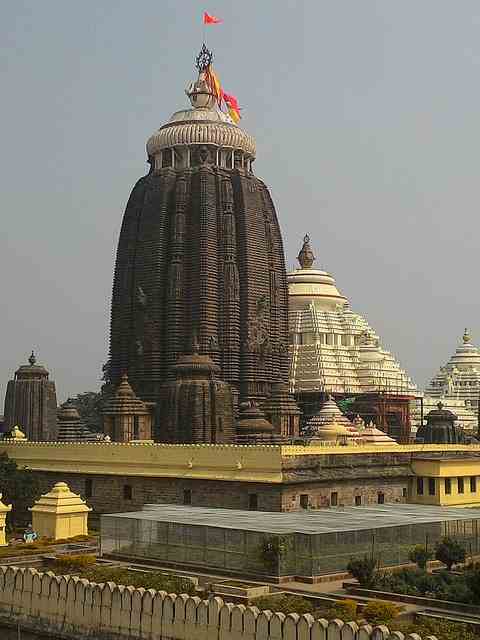Jagannath temple in Puri is one of the holiest places of Char Dham. You will be surprised to know that there are many mysteries surround this temple that has no explanation.

Sudarshan Chakra
Sudarshan Chakra is Lord Vishnu’s most powerful weapon. It is considered one of the most powerful weapons ever used in the cosmic world.
According to Agni Purana, the Sudarshan Chakra of Lord Vishnu after being cursed for its ego, the Lord blessed it to be worshipped with Lord Jagannath. Read the full story of the Jagannath temple from the time of Puranas.
Inside Lord Jagannath temple, Lord Vishnu’s wheel is worshipped in the name of ‘Sudarshana’. But in the temple, Sudarshana is worshipped in the shape of a small wood, pillar placed to the left of the image of Lord Jagannath.
Disappearance Of Sri Chaitanya Mahaprabhu
Sri Chaitanya Mahaprabhu of Gaudiya Vaishnavism stayed in the Jagannath temple for 24 years, establishing that the love of God can be spread by chanting the Hare Krishna mantra. His last days were spent in Puri. His passing is still shrouded in mystery.
At the age of 45, he entered the temple and came out no more, simply disappearing. Some believe that Sri Chaitanya merged with Lord Jagannath’s idol, while some conspiracy theories believe that he was buried under the floor of the temple.
Neela Chakra
The Neela Chakra at the top of Lord Jagannath temple is the symbol of Lord Jagannath. The wheel is made of eight metals comprising iron, copper, zinc, mercury, lead, brass, silver, and gold. It is so designed that there is a wheel within the wheel.

It can be seen from anywhere from Puri. If you see it from anywhere, it looks like that it is facing is towards you.
The Neela Chakra has been destroyed and reconstructed many times. In the year 1694, the Neela Chakra had fallen due to a heavy cyclone and the temple was without Neela Chakra for some years. The present Neela Chakra is more than 270 years old.
The most wonderful thing about the Neela chakra is that it changes its colors throughout the day. In the morning when the sun rises, the color becomes red. In sunlight, it changed to blue. It looks like a shade of Purple in the sunset which is very attractive.
The weight of Neela Chakra is 2200 Kg. One of the mysteries surrounding this Chakra is which technique was used back then to install this heavy Chakra. Nobody knows whether hundreds of years ago any machinery was used or was it put up there by some human force?
The Blue Wheel protects the high-rise temple from thunder strokes and lighting. Neela Chakra is made of Asthadhatu. The eight metal alloy can absorb the ferocity of thunderbolts and thus the gigantic stone monument remains unharmed.
There is a specific category of people among the temple servitors to serve the Neela Chakra and they are known as Garuda Sevaka or Chunara Nejoga.
Puri Temple Flag – Patitapavan Bana
The flag which is at the Top of the Puri temple is called Patitapavan Bana, which means who recovers people from their sins. It has a religious significance.
People in East coast India believe this Flag is the protector of Natural disasters. If it is not flowing then it is a bad omen.
The flag’s color is red or yellow and in the center a sign of half-moon or sun in the color of white.
Every day a priest climbs atop the temple, which is as tall as a 45 storey building, to change the flag. There is a rule that if this ritual is ever missed, then the temple will remain shut for the next 18 years.
The sevayat before climbing the temple dress in proper clothing. The upper part of his body remains bare and he wears silk cloth. He climbs the wall in a very peculiar manner, his back to the wall and his two outstretched legs on two raised parts of the wall.
Puri Temple Mahaprasad
The temple’s kitchen is the largest in the world. Tradition holds that all Mahaprasad cooking in the temple kitchens is supervised by the Goddess Mahalakshmi. There is a belief that if a shadow dog appears near the temple kitchen, then the food prepared has some fault in it. The food is promptly buried and a new batch is cooked.
The prasadam never gets wasted or is insufficient on any given day.
500 cooks and 300 helpers prepare the Prasad. Earthen Pots are used to cook this special delicacy using firewood. 7 clay pots are used for this and they are placed one on top of another. The contents of the topmost pot get cooked first, followed by the bottom pots.
Snana Yatra At Jagannath Temple
During the Snana yatra (bathing festival), which occurs on the full moon day of the month of Jyestha (May-June), the deities are given a ceremonial bath on a bathing platform outside the temple. However, the bath discolored the painted wooden statues. Thus, for fifteen days, the deities are considered to be ill and are not to be viewed by the public. This period of illness is called Anasara (or Anavasara). During this period, the statues are repaired as necessary, and on the fourteenth day of the illness, they are repainted by a particular painter who has been chosen for this Seva or service.
The Temple Structure
Among the wonderful things about the temple, the shadow of the top part of the temple is never visible at any given time of the day. It remains to be deciphered whether it is an engineering marvel or a phenomenon that can be attributed only to the divine force.
No Birds Fly Or Sit At The Temple
The height of the temple is more than 1000 ft, and there are not many birds found in this area that can fly above that height. Eagle is an exception. In July 2020, an eagle was seen perched atop the Patitapaban Bana (Flag) of the Lord Jagannath temple in Puri. Servitors regarded it as a bad omen.
As for Planes, they do not fly because of a lack of commercial value.
Nabakalabera
Nabakalabera is a ritual associated with Jagannath which takes place every 8, 12, or 18 years when one lunar month of Ashadha is followed by another lunar month of Aashadha. Meaning “New Body”, the ritual involves the installation of new images in the Jagannath temple and the burial of the old images at the temple at Koili Vaikuntha.
The selection of the four darus(logs) for the making of the idols of Lord Jagannath, Lord Balabhadra, Devi Subhadra, and Lord Sudarshan is supposed to be a divine exercise. Goddess Mangala coming in the dream of a priest and tell him the exact location of the tree for each of the deities.
Margosa(Neem) tree trunk is used to prepare the idols. Old idols are drowned and new idols are prepared. NABAKALBERA. How the trees are selected. Havan is done there and then the tree is cut.
The festival is witnessed by millions of people. Last Nabakalevara happened in 2015, making it one of the most visited festivals in the world.
Brahma Padartha Of Jagannath
Brahma padartha is the most discussed subject in Nabakalebara. They are the core materials in the four wooden deities of the Sri Jagannath temple. These core materials are transferred from the old idols to the new in a metaphor of immortality of the soul and its reincarnations.
The identity of Brahma padartha a closely guarded secret. Many believe it to be the mortal remains of Lord Sri Krishna. Some others claim that it may be a tooth of Gautama Buddha, while, some believe that it is a Shaligram. Yet, its identity is still shrouded in mystery.
Rath Yatra
Ratha Yatra is organized each year at the famous Jagannatha temple in Puri, Odisha. On this day, the idols of Lord Jagannath, Goddess Subhadra, and Lord Balabhadra are decorated in chariots drawn by hundreds of devotees every year.
To pull the ropes, people from all over the world come here. There is a belief that devotees will attain moksha if they touch the rope.
Khajana In The Temple
150 Kg of antique and priceless pieces of jewelry of gold besides diamonds and precious gems of the Mahaprabhu (Jagannath) have been kept in the Ratna Bhandar of the temple. They have rich historical and cultural value as well.
The Ratna Bhandar consists of seven rooms, located close to the Nata mandir. The outer chamber has jewelry that the Lord uses daily and the inner chambers have ornaments that are not being used.
Non-Hindus Not Permitted In The Temple
There is a long list of eminent personalities, who have not been allowed in the Puri temple. When Mahatma Gandhi visited Puri with his entourage including Muslims and Christians, he was denied entry.
B.R. Ambedkar, Indira Gandhi, Rabindranath Tagore, and many other scholars were barred entrance on the temple.
The temple has a board saying non-Hindus are not allowed. As per temple rules, only the Shankaracharya has the authority to make exceptions and changes.
Foreign Invaders In Puri Jagannath Temple
The Jagannath temple at Puri is a survivor of a violent history. It had been invaded and plundered eighteen times.
Almost every time, the idols were saved in the nick of time and taken elsewhere. But, in no case, the Bramha Padartha of the deities were destroyed. Every time the worship resumed after the idols were brought back to Puri.
The servitors and the Kings have played a crucial role in safeguarding the deities at the time of danger. In Ayodhya, Kasi, and Mathura, the mosques have been built in place of the temples due to Muslim invasion. At Puri, Lord Jagannath remained standstill at the time of the seizure.





[…] Jagannath temple is there. Read the story of the Jagannath temple from the time of Puranas and the mysteries surrounding the Jagannath temple. Pilgrims take a purification dip at Puri sea before entering the temple. Due to the presence of […]